Amy Wallace (July 3, 1955 – August 10, 2013)
13 September 2013
Hard to believe it was her time to go. She helped me so much over the nine years that I worked for her. I took care of her house when she went to L.A. to be with Carlos. She didn't want her mother to know she was in town so the charade was that Amy was 'out' whenever she called, which was often. Felt so bad at the encouragement I gave regarding Carlos as it looked like a pretty close call when all the others killed themselves. I've thought about her every day since because things ended in a snarl of miscommunication of exchanged emails, some of which AT&T put in my 'master' email, kind of like facebooks other inbox, so it appeared to both of us that the other had gone round the bend. Well I guess the thinking about that won't stop but now minus the fantasy of repairing the friendship. fuck. fuck. fuck fuck
Favorite line of hers: If absurdity could kill I'd be dead today
"Florinda then introduced Carol to the group as "the nagual woman" who had disappeared into Infinity -- also referred to as "the Second Attention" -- for 10 years, body and all. It felt to her like a second, Florinda told us -- she lost all sense of time. "When Carol miraculously reappeared, jogging in her sweat-suit," Florinda continued incongruously, "she opened the magical door that allowed me to be here tonight, the door that has allowed Carlos to begin giving public appearances." Woman Returns From
Infinity Still Jogging, Sweatsuit Intact. If absurdity could kill, I would be dead today."
Carlos Told Amy she had to get rid of her cats. Could I help. That was the first sign of trouble as the cats were indoor cats for the most part and were promptly killed up in the country. I worked for her for nine years took care of the house, drove her to the Sunset for Chi Gung where a little old Chinese opera star would stand there as a big Irish galump came galumphing across the floor and straight arm her shoulders, spring over backward without ruffling her a bit aand role in a ball back the length of the room. I taught her to drive, well brush up on her skills from when she quit thirteen years before. I drove her to Napa to a psychic reader who said she would meet a millionaire in a year. A year or so later Carlos called.
Amy didn't fare that well in what she called the high school atmosphere around Carlos. When he died all the witches committed suicide. Only one body was found so this is partly conjecture based on the fact that they had considerable money coming to them, all disconnected their phone and talked of suicide as Carlos died. It's not clear that he ever got any closer to Mexico than the stacks in UCLA's library. He talks of strolling through the desert in July and having a jolly time, no mention of bugs and the terrible heat. He never learned the Yaqui names of plants and has the Yaqui using peyote which they don't, the Huichol do. Richard deMille compiled a 47 page list of quotes from Don Juan that were lifted from all over. Con men are weird, they can't believe their stuff is going over and keep making it more blatant more obvious; toward the end Carlos was talking in tensegrity classes about a 200 lb legless pigeon that could never land. The dodge now among Bruce Wagner (who owns the rights to the books...ahem) is that they are teaching stories. The fact that they conveniently prep you to get caught up in his cult takes away from that line considerably. I saw him tear my friend apart, claim to not have sex in twenty years, 'marry" her, banish her, take her back on and on over a period of several years. He was friends with her father and used her father's death to get to her saying he dreamt that her father was trapped under her house tangled in vine and she and he had to save her father. Nice guy.
In de Mille’s first exposé, “Castaneda’s Journey,” which appeared in 1976, he pointed to numerous internal contradictions in Castaneda’s field reports and the absence of convincing details. “During nine years of collecting plants and hunting animals with don Juan, Carlos learns not one Indian name for any plant or animal,” De Mille wrote. The books were also filled with implausible details. For example, while “incessantly sauntering across the sands in seasons when … harsh conditions keep prudent persons away, Carlos and don Juan go quite unmolested by pests that normally torment desert hikers.”
De Mille also uncovered numerous instances of plagiarism. “When don Juan opens his mouth,” he wrote, “the words of particular writers come out.” His 1980 compilation, “The Don Juan Papers,” includes a 47-page glossary of quotations from don Juan and their sources, ranging from Wittgenstein and C.S. Lewis to papers in obscure anthropology journals.
In one example, de Mille first quotes a passage by a mystic, Yogi Ramacharaka: “The Human Aura is seen by the psychic observer as a luminous cloud, egg-shaped, streaked by fine lines like stiff bristles standing out in all directions.” In “A Separate Reality,” a “man looks like a human egg of circulating fibers. And his arms and legs are like luminous bristles bursting out in all directions.”
The accumulation of such instances leads de Mille to conclude that “Carlos’s adventures originated not in the Sonoran desert but in the library at UCLA.” De Mille convinced many previously sympathetic readers that don Juan did not exist. Perhaps the most glaring evidence was that the Yaqui don’t use peyote, and don Juan was supposedly a Yaqui shaman teaching a “Yaqui way of knowledge.” Even the New York Times came around, declaring that de Mille’s research “should satisfy anyone still in doubt.”
Some anthropologists have disagreed with de Mille on certain points. J.T. Fikes, author of “Carlos Castaneda, Academic Opportunism and the Psychedelic Sixties,” believes Castaneda did have some contact with Native Americans. But he’s an even fiercer critic than de Mille, condemning Castaneda for the effect his stories have had on Native peoples.
Following the publication of “The Teachings,” thousands of pilgrims descended on Yaqui territory. When they discovered that the Yaqui don’t use peyote, but that the Huichol people do, they headed to the Huichol homeland in Southern Mexico, where, according to Fikes, they caused serious disruption. Fikes recounts with outrage the story of one Huichol elder being murdered by a stoned gringo.
Amy at the Putney School
In “Sorcerer’s Apprentice,” Wallace provides a detailed picture of her own seduction. Because of her father’s friendship with Castaneda, her case was unusual. Over the years, he’d stop by the Wallace home. When Irving died in 1990, Amy was living in Berkeley, Calif. Soon after, Castaneda called and told her that her father had appeared to him in a dream and said he was trapped in the Wallace’s house, and needed Amy and Carlos to free him.
Wallace, suitably skeptical, came down to L.A. and the seduction began in earnest. She recounts how she soon found herself in bed with Castaneda. He told her he hadn’t had sex for 20 years. When Wallace later worried she might have gotten pregnant (they’d used no birth control), Castaneda leapt from the bed, shouting, “Me make you pregnant? Impossible! The nagual’s sperm isn’t human … Don’t let any of the nagual’s sperm out, nena. It will burn away your humanness.” He didn’t mention the vasectomy he’d had years before.
The courtship continued for several weeks. Castaneda told her they were “energetically married.” One afternoon, he took her to the sorcerer’s compound. As they were leaving, Wallace looked at a street sign so she could remember the location. Castaneda furiously berated her: A warrior wouldn’t have looked. He ordered her to return to Berkeley. She did. When she called, he refused to speak to her.
The witches, however, did, instructing Wallace on the sorceric steps necessary to return. She had to let go of her attachments. Wallace got rid of her cats. This didn’t cut it. Castaneda, she wrote, got on the phone and called her an egotistical, spoiled Jew. He ordered her to get a job at McDonald’s. Instead, Wallace waitressed at a bed and breakfast. Six months later she was allowed back.
Aspiring warriors, say Jennings, Wallace and Ward, were urged to cut off all contact with their past lives, as don Juan had instructed Carlos to do, and as Castaneda had done by cutting off his wife and adopted son. “He was telling us how to get out of family obligations,” Jennings told me. “Being in one-on-one relationships would hold you back from the path. Castaneda was telling us how to get out of commitments with family, down to small points like how to avoid hugging your parents directly.” Jennings estimates that during his four years with the group, between 75 and 100 people were told to cut off their families. He doesn’t know how many did.
For some initiates, the separation was brutal and final. According to Wallace, acolytes were told to tell their families, “I send you to hell.” Both Wallace and Jennings tell of one young woman who, in the group’s early years, had been ordered by Castaneda to hit her mother, a Holocaust survivor. Many years later, Wallace told me, the woman “cried about it. She’d done it because she thought he was so psychic he could tell if she didn’t.” Wallace also describes how, when one young man’s parents died soon after being cut off, Castaneda singled him out for praise, remarking, “When you really do it, don Juan told me, they die instantly, as if you were squashing a flea — and that’s all they are, fleas.”
NURY The Blue Scout
Whether disciples were allowed to stay or forced to leave seems often to have depended on the whims of a woman known as the Blue Scout. Trying to describe her power, Ward recalled a “Twilight Zone” episode in which a little boy could look at people and make them die. “So everyone treated him with kid gloves,” she said, “and that’s how it was with the Blue Scout.” She was born Patricia Partin and grew up in LaVerne, Calif., where, according to Jennings, her father had been in an accident that left him with permanent brain damage. Partin dropped out of Bonita High her junior year. She became a waitress, and, at 19, married an aspiring filmmaker, Mark Silliphant, who introduced her to Castaneda in 1978. Within weeks of their marriage she left Silliphant and went to live with Castaneda. She paid one last visit to her mother; in keeping with the nagual’s instructions, she refused to be in a family photograph. For the rest of her life, she never spoke to her mother again.
Castaneda renamed Partin Nury Alexander. She was also “Claude” as well as the Blue Scout. She soon emerged as one of his favorites (Castaneda officially adopted her in 1995). Followers were told he’d conceived her with Tiggs in the nagual. He said she had a very rare energy; she was “barely human” — high praise from Castaneda. Partin, a perpetual student at UCLA and an inveterate shopper at Neiman Marcus, was infantilized. In later years, new followers would be assigned the task of playing dolls with her.
Carlos gets sick
f Castaneda’s early books drew on Buddhism and phenomenology, his later work seemed more indebted to science fiction. But throughout, there was a preoccupation with meeting death like a warrior. In the ’90s, Castaneda told his followers that, like don Juan, he wouldn’t die — he’d burn from within, turn into a ball of light, and ascend to the heavens.
In the summer of 1997, he was diagnosed with liver cancer. Because sorcerers weren’t supposed to get sick, his illness remained a tightly guarded secret. While the witches desperately pursued traditional and alternative treatments, the workshops continued as if nothing was wrong (although Castaneda often wasn’t there). One of the witches, Abelar, flew to Florida to inspect yachts. Geuter, in notes taken at the time, wondered, “Why are they buying a boat? … Maybe Carlos wants to leave with his group, and disappear unnoticed in the wide-open oceans.”
No boats were purchased. Castaneda continued to decline. He became increasingly frail, his eyes yellow and jaundiced. He rarely left the compound. According to Wallace, Tiggs told her the witches had purchased guns. While the nagual lay bedridden with a morphine drip, watching war videos, the inner circle burned his papers. A grieving Abelar had begun to drink. “I’m not in any danger of becoming an alcoholic now,” she told Wallace. “Because I’m leaving, so — it’s too late.” Wallace writes: “She was telling me, in her way, that she planned to die.”
Wallace also recalls a conversation with Lundahl, the star of the Tensegrity videos and one of the women who disappeared: “If I don’t go with him, I’ll do what I have to do,” Wallace says Lundahl told her. “It’s too late for you and me to remain in the world — I think you know exactly what I mean.”
In April 1998, Geuter filmed the inner circle packing up the house. The next week, at age 72, Castaneda died. He was cremated at the Culver City mortuary. No one knows what became of his ashes. Within days, Donner-Grau, Abelar, Partin, Lundahl and Marquez had their phones disconnected and vanished. A few weeks later, Partin’s red Ford Escort was found abandoned in Death Valley’s Panamint Dunes.
Even within the inner circle, few knew that Castaneda was dead. Rumors spread. Many were in despair: The nagual hadn’t “burned from within.” Jennings didn’t learn until two weeks later, when Tiggs called to tell him Castaneda was “gone.” The witches, she said, were “elsewhere.”
Castaneda’s will, executed three days before his death, leaves everything to an entity known as the Eagle’s Trust. According to Jennings, who obtained a copy of the trust agreement, the missing women have a considerable amount of money due to them. Deborah Drooz, the executor of Castaneda’s estate, said she has had no contact with the women.
Jennings believes Castaneda knew they were planning to kill themselves. “He used to talk about suicide all the time, even for minor things,” Jennings told me. He added that Partin was once sent to identify abandoned mines in the desert, which could be used as potential suicide sites. (There’s an abandoned mine not far from where her remains were found.) “He regularly told us he was our only hope,” Jennings said. “We were all supposed to go together, ‘make the leap,’ whatever that meant.” What did Jennings think it meant? “I didn’t know fully,” he said. “He’d describe it in different ways. So would the witches. It seemed to be what they were living for, something we were being promised.”
The promise may have been based on the final scene in “Tales of Power,” in which Carlos leaps from a cliff into the nagual. The scene is later retold in varying versions. In his 1984 book, “The Fire From Within,” Castaneda wrote: “I didn’t die at the bottom of that gorge — and neither did the other apprentices who had jumped at an earlier time — because we never reached it; all of us, under the impact of such a tremendous and incomprehensible act as jumping to our deaths, moved our assemblage points and assembled other worlds.”
Did Castaneda really believe this? Wallace thinks so. “He became more and more hypnotized by his own reveries,” she told me. “I firmly believe Carlos brainwashed himself.” Did the witches? Geuter put it this way: “Florinda, Taisha and the Blue Scout knew it was a fantasy structure. But when you have thousands of eyes looking back at you, you begin to believe in the fantasy. These women never had to answer to the real world. Carlos had snatched them when they were very young.”
Wallace isn’t sure what the women believed. Because open discussion of Castaneda’s teachings was forbidden, it was impossible to know what anyone really thought. However, she told me, after living so long with Castaneda, the women may have felt they had no choice. “You’ve cut off all your ties,” she said. “Now you’re going to go back after all these decades? Who are you going to go be with? And you feel that you’re not one of the common herd anymore. That’s why they killed themselves.”
On its Web site, Cleargreen maintains that the women didn’t “depart.” However, “for the moment they are not going to appear personally at the workshops because they want this dream to take wings.”
Remarkably, there seems to have been no investigation into at least three of the disappearances. Except for Donner-Grau, they’d all been estranged from their families for years. For months after they vanished, none of the other families knew what had happened. And so, according to Geuter, no one reported them missing. Salon attempted to locate the three missing women, relying on public records and phone calls to their previous residences, but discovered no current trace of them. The Los Angeles Police Department and the FBI confirm that there’s been no official inquiry into the disappearances of Donner-Grau, Abelar and Lundahl.
There is, however, a file open in the Marquez case. This is due to the tireless efforts of Luis Marquez, who told Salon that he first tried to report his sister missing in 1999. But the LAPD, he said, repeatedly ignored him. A year later, he and his sister Carmen wrote a letter to the missing-persons unit; again, no response. According to Marquez, it wasn’t until Partin’s remains were identified that the LAPD opened a file on Amalia. “To this day,” he told me, “they still refuse to ask any questions or visit Cleargreen.” His own attempts to get information from Cleargreen have been fruitless. According to Marquez, all he’s been told is that the women are “traveling.” Detective Lydia Dillard, assigned to the Marquez case, said that because this is an open investigation, she couldn’t confirm whether anyone from Cleargreen had been interviewed.
In 2002, a Taos, N.M., woman, Janice Emery, a Castaneda follower and workshop attendee, jumped to her death in the Rio Grande gorge. According to the Santa Fe New Mexican, Emery had a head injury brought on by cancer. One of Emery’s friends told the newspaper that Emery “wanted to be with Castaneda’s people.” Said another: “I think she was really thinking she could fly off.” A year later, a skeleton was discovered near the site of Partin’s abandoned Ford. The Inyo County sheriff’s department suspected it was hers. But, due to its desiccated condition, a positive identification couldn’t be made until February 2006, when new DNA technology became available.
Wallace recalls how Castaneda had told Partin that “if you ever need to rise to infinity, take your little red car and drive it as fast as you can into the desert and you will ascend.” And, Wallace believes, “that’s exactly what she did: She took her little red car, drove it into the desert, didn’t ascend, got out, wandered around and fainted from dehydration.”
The media didn’t learn of Castaneda’s death for two months. When the news became public, Cleargreen members stopped answering their phones. They soon placed a statement, which Jennings says was written by Wagner, on their Web site: “For don Juan, the warrior was a being … who embarks, when the time comes, on a definitive journey of awareness, ‘crossing over to total freedom’ … warriors can keep their awareness, which is ordinarily relinquished, at the moment of dying. At the moment of crossing, the body in its entirety is kindled with knowledge … Carlos Castaneda left the world the same way that his teacher, don Juan Matus did: with full awareness.”
Mostly I remember carving the slate that the pitcher sits with Gloria, two, in a backpack, slivers flying to the right and left. The raccoons were sure we had made them a water toy and put the automatic refill hose to work filling the neighbor's yard. They managed to fill the yard more than an inch deep which alarmed the neighbor so much, YOU’RE GOING TO WASH MY HOUSE DOWN THE HILL.
The urn and the slate base are in forced perspective. The base is raked in other words. This was made before Amy went to L.A. to be with Carlos Castaneda. He directed her to get rid of her cats. I arranged for them to go to people I knew in the country. That didn’t go well, they were mostly indoor city cats and didn’t last long.
Lots of work on a writing room. A ten foot table which I still have, cut down and sconces on all four corners. Carlos style feng shui. What building codes?: the sconces were a light fixture a bit of expanded metal lathe and me throwing plaster of Paris at the lot and the cord hanging and going to a plug. They were beautiful chinoiserie shells.
The white concrete catch basin was made on site with a big piece of sonotube. While making it it went through my mind like an earworm that white concrete can last for 5,000 years. It rested on a 600 lbs piece of black slate. It barely lasted three years; the people who bought the house wrecked it first thing, dug a hole and broke it up. They wanted to make an apartment in what was a recording studio. The fountain was made in one of the boarded up windows. I went back with my daughter while they were still working on the house and all that was left was the urn with the base broken off. So we spirited it away.
Designed by Maybeck’s brother in law. One of the sweetest houses anywhere. Even with the stairwell, on the third floor you were oblivious to the activity in the rest of the house. There was a back staircase next to the kitchen up to the second floor, essential for avoiding people.
Inside the gate was an eighty year old weeping birch that I cut down with a rented garden chain saw. A tiny thing. At the crucial moment a guy stopped to ask directions of my girlfiend who was there to warn cars off. Dropped it in the street. Missed him.
One last thing: when I painted the trim I used all organic materials. The organic window putty was mostly linseed paste and linseed oil. Amy called and said there is something banging on the house. Won’t stop. When I got there I heard it too and traced it to where a blackbird was eating it, putting big holes in my work.
.

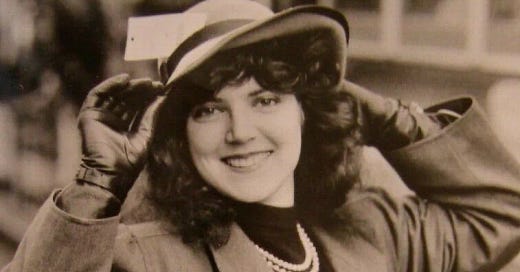



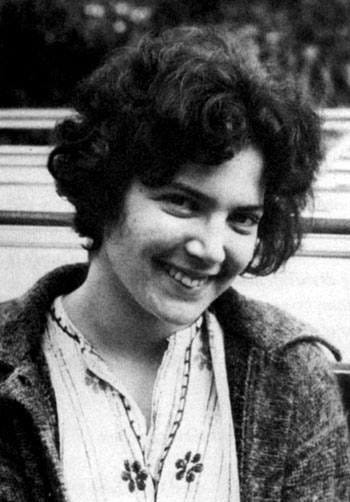
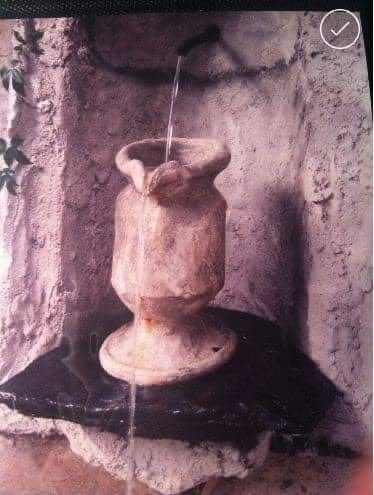
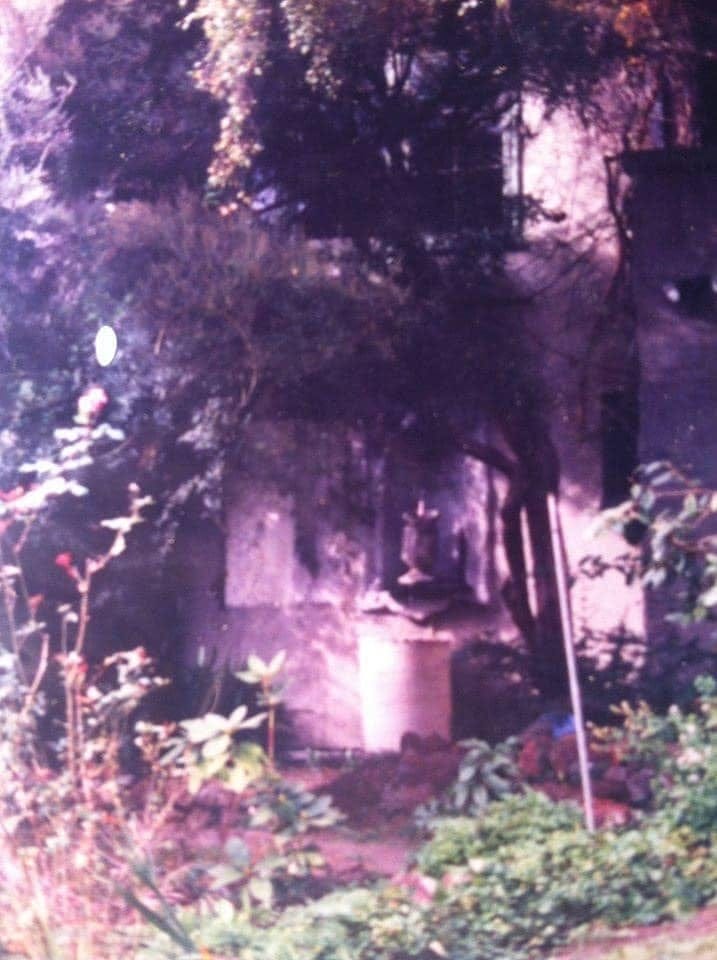
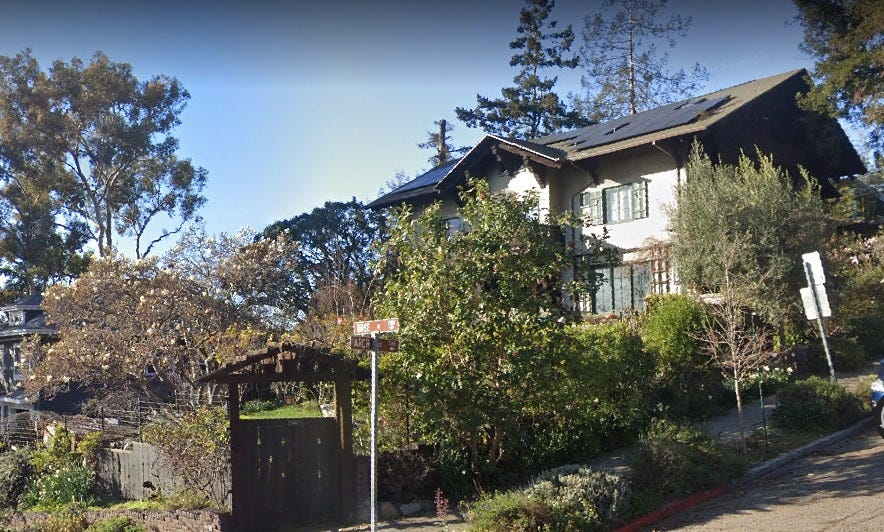


I really liked Don Juan a Yaqui Way of Knowledge even though I didn't understand most of it. The rest of the books ... meh. I liked a phrase that is probably not a quote but a paraphrase: "Make death your ally." I interpreted this to mean that if you realize you're not going to go on forever and that you will die then you might live more fully in the moment. The worst cult I ever got into was TM. I lived for a while in Fairfield and one day I realized that nothing bad would happen if I didn't meditate. I still like the way TM makes me feel so there ya go.